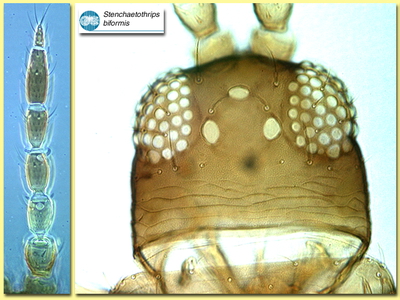Figures
Fig. 1 Antenna and head (dorsal)
Fig. 2 Pronotum
Fig. 3 Fore and hind wing
Fig. 4 Meso- and metanotum
Fig. 5 Tergite VIII
Fig. 6 Sternites III-VII
Species
Stenchaetothrips biformis Bagnall
Biology
The rice thrips is a serious pest of seedling rice in many Asian countries, causing feeding damage to the leaves, but it also breeds on other Gramineae that live in or close to water.
Distribution
Widespread throughout Asia, but populations also reported from Romania, England, and Guiana. Recorded from grasses in Australia, but not reported from rice in this country.
Recognition
Small brown thrips with shaded forewings, and antennal segments III & IV yellow. Antennae 7-segmented, sense cones on III & IV small and forked. Head with no setae immediately in front of first ocellus, but with one long pair anterolateral and close to the compound eyes (pair II), and one small pair on anterior margins of ocellar triangle. Pronotum with 2 pairs of long posteroangular setae. Metanotal lines of sculpture linear and sub-parallel on posterior half but transverse on anterior; median setae not at anterior margin. Forewing first vein with 3 setae on distal half. Tergite II with 4 lateral marginal setae; V-VIII with a ctenidium laterally, on VIII posteromesad of spiracle; VIII with complete posteromarginal comb of long microtrichia. Sternites without discal setae, posterior margins bearing small tuberculate microtrichia. Male tergites with small teeth on posterior margin that point laterally away from the midline; sternites III-VII with transverse glandular area.
Related species
More than 20 species are listed in this genus, mainly from south east Asia, all of them associated with Gramineae. They are very similar to species of Thrips, but have the anterolateral pair of ocellar setae (pair II) much longer than the median pair (pair III).







